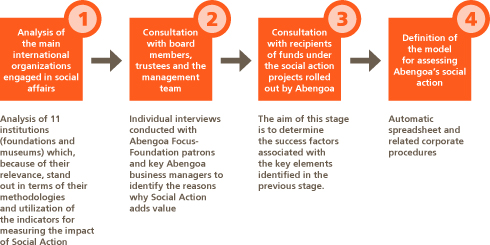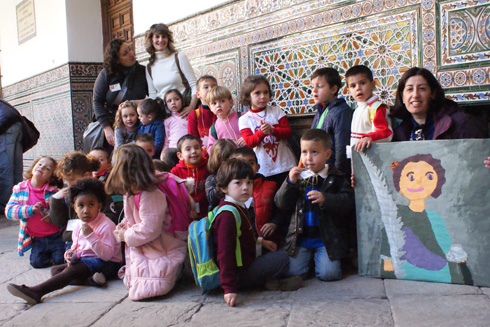 Abengoa
Abengoa
Annual Report 2010
- Corporate Social Responsibility Report
- Abengoa and the Community
- Preservation, Dissemination and Advancement of Art and Culture
One of the overriding aims of the Focus-Abengoa Foundation is to promote culture internationally in its many different artistic and scientific guises, through cultural activities such as concerts, exhibitions and seminars.
Hospital de los Venerables
Hospital de los Venerables is one of the Seville’s best-conserved examples of Baroque architecture dating back to the second half of the seventeenth century. It can be found in the Santa Cruz neighborhood and has been the head offices of the foundation since 1991. Following the restoration work carried out between 1989 and 1991, the foundation has ensured that the hospital remains open and available to the public through the promotion of cultural and educational activities, such as visits from schools, the public in general, closed-door cultural tours, concerts, exhibitions and conferences.
Library on Seville
Following completion of the restoration work on the foundation’s current head offices, the bibliographic heritage, which has been steadily amassing since 1981, was stored in what was then the refectory and chapter house of the hospital.
The library now contains over 6,000 works, spanning the 16th to the 21st century. The foundation regularly exchanges publications with both national and international institutions.
Engravings Room
Since its inception back in 1982, the foundation has always boasted an impressive number of prints and engravings relating to Seville and its former kingdom.
In 1996, the close to 300 engravings acquired by the Focus-Abengoa Foundation over the years were conserved, sorted in folders and duly catalogued. When carrying out this lengthy scientific process, the foundation enjoyed the collaboration of the then Director of National Engravings, Juan Carrete Parrondo, along with Jesusa Vega and Gloria Solache.
The collection is divided into four periods:
- Baroque engravings.
- Engravings from the age of enlightenment.
- Romantic engravings.
- Contemporary engravings.
Collection of Paintings, Sculptures and Graphic Works
This collection comprises more than 200 works of art, which have been collected through activities and events such as the painting award and monographic exhibitions on renowned figures from the contemporary artistic world, along with numerous foundation acquisitions and donations.
Each year, the collection is expanded through the incorporation of prize-winning works from the different editions of the painting award, and through the acquisition of works selected through the award.
Over the course of 2010, the collection was bolstered by four sculptures of Gustavo Torner, from the series “La rectitud de las Cosas: XXXI, XXXII, XXXIII and XXXIV”.
The Diego Velázquez Research Center
Ever since its creation in 2007 on occasion of the acquisition of Velázquez’s “Santa Rufina”, the research center has been heavily involved in researching, debating and raising awareness of Velázquez during the time he spent in Seville. Before the inception of the research center, there had been only scant coverage of his works and artistic legacy over this important period of his life.
Permanent Collection
The permanent collection comprises sixteen works on display at the Velázquez Center, six of which belong to the Focus-Abengoa Foundation, while the rest are on loan from a range of different institutions, including the Museo Nacional del Prado, Seville City Hall, the Archbishopric of Seville and the Hispanic Society of New York. All have been selected with educational and scientific ends in mind.
Educational Program
Educational visits to the permanent collection have proved hugely popular with schools and the public in general. They are conducted by students and graduates from the universities of Seville. In 2010, the Elderly Cultural Volunteers group (“Voluntarios Culturales Mayores”) also became involved in this activity. In tandem with this, an activities workshop has been created, affording participants the chance to put the knowledge acquired from the visit into practice.
Music
The Focus-Abengoa Foundation boasts nineteen years of experience in offering high quality musical events under the direction of José Enrique Ayarra, organist at Seville Cathedral and Hospital de los Venerables. The organ was constructed by Gerhard Grenzing in 1991.
The foundation stages “Promotional concerts for budding organists”, providing young people studying at the National Higher Conservatories of Music with the chance to showcase their skills. Broadcasts of their performances over the RNE Radio Clásica radio station provide yet a further incentive for these talented young performers.
The foundation also arranges a “Cycle of Virtuoso Concerts”, featuring Europe’s leading organists.
Educational organ recitals are held for students enrolled in compulsory secondary education. These events combine the theory of organ music with renditions of works for organ.
Recovering Roman Bética
Abengoa is implementing its Solúcar Platform energy project in Sanlúcar la Mayor (Seville), which rests alongside the ever-popular “Corredor Verde del Guadiamar” (Guadiamar Green Belt).
The presence of numerous archaeological sites in the surrounding area has meant that adjustments have had to be made to the design of the facilities in order to ensure that these sites remain undisturbed. Abengoa entrusted the foundation with an extensive project to valorize the archaeological heritage to be found in the surrounding area.
The valuation of this heritage proved to be the driving force behind this project. The initiative has been designed with the specific aim of combining historic research with innovation, sustainability and social and cultural interest.
When the time came to conduct the required studies and work, the Focus-Abengoa Foundation enjoyed the close collaboration of the Archaeological Prospection Service attached to the Archaeology Department of Southampton University (United Kingdom) and the Department of Prehistory and Archaeology of Seville University.
Over the summer months, the teams conducted archaeological digs at the Lagunillas site, to the south of the Casa Quemada estate in Sanlúcar la Mayor (Seville) and resting alongside the Solnova 1 plant of the Solúcar Platform. In charge of these digs were Enrique García Vargas and Fernando Amores, both professors at the Prehistory and Archaeology Department of Seville University. Numerous professionals were involved in the digs, including five archeological technicians, five students enrolled on the master’s degrees in archaeology at Seville and Granada Universities, eight students from the University of Seville, and two female students from the Universities of Montpellier (France) and Sassari (Italy).
The digs were conducted in four stages: The first corresponded to the last years of the I century and moving into the II; the second covered all the III century and the first few decades of the IV; the third spanned halfway through the IV century to the close of the V or onset of the VI; while the fourth related to the end of Late Antiquity (VI and VII centuries) and the onset of Moorish occupation (Paleo-Andalusian period: VIII and IX centuries).
Of the two sites examined, the first, measuring 10 x 10 m, provided scant remains of Roman buildings, burial sites and late antiquity and emir materials.
The second area covered 30 x 20 m and was, in contrast, rich in finds. These included a street (this being a particularly important finding in that streets configure urban spaces) and the remains of buildings on either side of the same street, with repeated signs of craftsmanship, such as glass melting and metallurgy, and elements relating to agriculture and livestock breeding, all of which appeared to characterize this part of the site during Roman times and the Late Antiquity.

Revamping of the “Explore Seville. Five Glances through Five Engravings” Exhibition
The Focus-Abengoa Foundation has reopened the engravings exhibition, featuring works from the engravings section. The event has Alfonso Pleguezuel and Alberto Oliver as curators, while Gustavo Torner is in charge of museographic design.
The exhibition is split into five distinct sections offering different perspectives of the city of Seville.
In its new incarnation, visitors can use interactive screens to compare the panoramic engraving of the Seville cityscape on display at Madrid’s Museo Naval (Symon Wynhoustz Frisius, 1617), with the “View of Seville” (“Vista de Sevilla”) canvas (anonymous, c. 1650-1660), which belongs to the Focus-Abengoa Foundation. Two images taken from the same viewpoint in the Seville neighborhood of Triana, but representing snapshots of the city taken at two different times. The first, a Seville moving into the start of the seventeenth century, and the second, a Seville embroiled in crisis midway through the century and which its author created from an engraving of Mathäus Marian (1593-1650), also in the possession of the foundation.
The exhibition also features an educational program aimed at school pupils of all ages, who are given guided tours by young students of Seville University, who have become impartially involved in the educational activities arranged by the foundation. The foundation has also installed an audio tour, as well as free entry to the exhibition on Sunday afternoons.
After the educational visit, school children wrap up their visit to the foundation with an activity that allows them to put into practice the concepts explained during the tour in relation to the different engraving techniques and functions. At the end of this workshop, participants are fully able to explain the process of how engravings are made and compare and comment on the images.


Gustavo Torner Sculptures
The Focus-Abengoa Foundation has increased its artistic heritage through the acquisition of four sculptures by Gustavo Torner (painter, sculptor, illustrator and engraver attached to the so-called “Grupo de Cuenca” – “Cuenca School”). The sculptures in question belong to the series “La rectitud de las cosas” and are currently located at Campus Palmas Altas:
- La Rectitud de las Cosas XXXI.
- La Rectitud de las Cosas XXXII.
- La Rectitud de las Cosas XXXIII.
- La Rectitud de las Cosas XXXIV.
This marks an unprecedented addition to our collection of contemporary art, and is our first example of outdoor sculpture, which had hitherto been sadly missing from the collection. The sculptures are currently displayed on both the terraces and in the central square of Campus Palmas Altas, meaning that they can be seen by Abengoa employees and visitors alike. They can also be seen within the corporate headquarters designed by Richard Rogers.

Assessing the Effectiveness of Abengoa Contributions to the Community
In an attempt to evaluate and gauge the effectiveness of its contributions to society, Abengoa has launched a project with the ultimate aim of devising a model that will allow the company to weigh up the tangible and intangible impacts of its social actions.
The growing importance of being able to evaluate investments within society stems from the need to provide evidence and transparency regarding the achievements or returns on investments, and similarly to ensure that resources are managed efficiently, thus ensuring that the investment has the maximum possible effect.
With this in mind, Abengoa has developed a four-step approach that will provide the company with a practical, simple and improved analytical tool for evaluating its social impact.

An analysis of each project leads to a graphic representation of its impact on affected stakeholders, in addition to a Social Return on Investment (SROI) ratio, illustrating just how effective the investment has been at generating social value.
